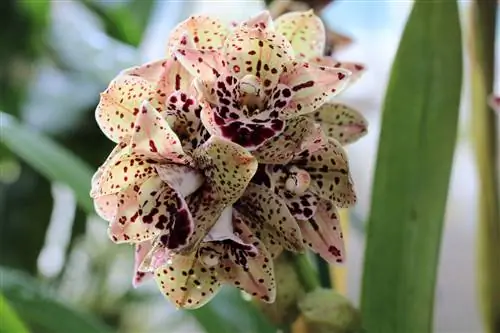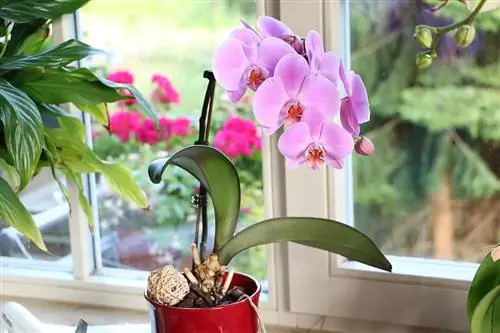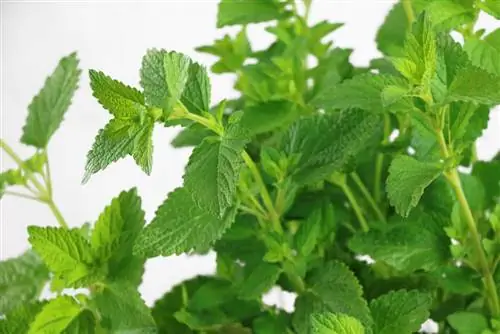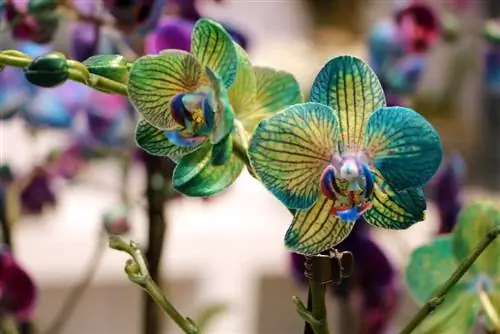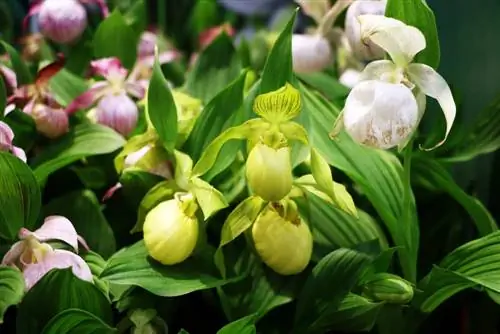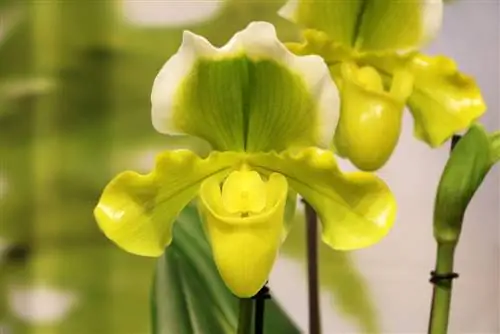- Author admin [email protected].
- Public 2023-12-17 03:39.
- Last modified 2025-01-24 12:45.
Cymbidium orchids prefer bright locations without direct sunlight and love to be watered moderately and fertilized with liquid fertilizer while growing. The soil should be a mixture of two parts Osmunda fibers and one part each of compost soil and sphagnum.
Orchid species from the genus Cymbidium
The orchid lover describes the small orchids as the most beautiful. Plants that produce up to 35 flowers up to 8 cm in size in one season are particularly popular. The flowers in yellow, green, mahogany red, rose red or white are usually very fragrant. The flower opens above the stem over a period of several weeks, from winter to the early summer months. Cybidium orchids thrive in bright bathrooms as long as they are not exposed to direct sunlight. Hybrids are almost exclusively found in cultivation. These are grouped under Cymbidium hybrids. Here are some examples of the most popular varieties:
- One of the smaller forms is the Cymbidium devonianum 'Minuet', with 30 to 40 cm long flower stalks and up to 20 flowers in the colors green, yellow or brown with a dark spotted lip and a diameter of 2 to 3 cm.
- The hybrid Cymbidium devonianum 'Peter Pan' with 25 to 35 cm long flower stalks has around 10 to 15 greenish-yellow flowers with mahogany-red, spotted lips. This flower reaches a diameter of 2 to 3 cm.
- The Cymbidium devonianum is also one of the smaller forms. Many other hybrids come from this. The approximately 5 to 6 cm long pseudobulbs form 3 to 5 green, leathery leaves with a width of 7 cm and a length of 15 to 35 cm. 25 to 35 cm long flower stalks form 8 to 10 flowers of yellow-olive green color with crimson markings and lips. The lip is colored a little lighter than the drawing.
Popularity and Location of Cymbidium Hybrids
The large orchid species have not been able to establish themselves as popular indoor orchids, even though they have attractive and long-lasting flower spikes. On the one hand, this may be due to their size, up to a meter high and spreading, which is why the small orchids are preferred, and on the other hand, due to the temperature change from extremely warm during the day to a cold night. This is difficult to do in the apartment. The optimal location for these small orchids is a bright place in the living room, preferably with morning and evening sun. On the balcony or in the garden, the cymbidiums prefer a partially shaded spot in the summer months. Since the fluctuating day and night temperatures are very important for the development of the inflorescences, the places can be swapped. In winter in the indoor area, which is only heated during the day and in summer in the garden or on the balcony.
Ideal winter temperatures are between 10 and 20 °C. The orchid tolerates some fluctuations up or down very well. Outdoors and in the summer months it can tolerate temperatures of 30 °C, but needs to be reduced to ideally 10 °C at night. Mini varieties of cymbidiums feel right at home at around 20 °C during the day and 17 °C at night. If the night setting cannot be achieved, the new bulbs will not form flowers. The cymbidiums also love high humidity of 60 to 80%. Indoors, this can be achieved by placing bowls of water.
Cymbidium hybrids
- 'Annan Cooksbridge' is a miniature form with 6cm wide upright spikes of deep blood red, white edged flowers. The lips have black speckles.
- 'Clarisse Carlton' has upright spikes of dull pink, white-edged flowers. The white lips are lined with blood red and mottled as well as spotted yellow.
- 'Elmwood' shows overhanging spikes of cream-colored flowers that run pink towards the edge and are characterized by yellow, red-lined lips.
- 'Fort George Lewes' produces upright spikes of green flowers up to 13 cm wide. A sprout produces flowers. This hybrid is considered one of the most beautiful green cymbidiums.
Care, fertilization and soil for small orchids
You should only fertilize in moderate concentrations during the growing season with liquid fertilizer or special orchid fertilizer that has a high nitrogen content. However, they should be watered abundantly in the summer months and while flowers and leaves are growing. The bark-based substrate used should be completely saturated. The substrate should dry out between each watering, but not dry out. In the winter months the cymbidiums are only watered sparingly. The irrigation water should be lukewarm and stale for about 30 minutes so that the chlorine gas can escape. Watering too often can cause rot and watering too little prevents flower and leaf formation. The soil ideally consists of a mixture with two parts Osmunda fibers and one part each of compost soil and sphagnum. To avoid waterlogging, shards of pottery or coarse pebbles are placed on the bottom of the pot, and if the saucer is full of water, this must be removed.
Propagate and repot orchids
Since the cymbidiums are perennial and can get very old, they expand extremely over the years. The shoots sit close together, which makes repotting and dividing difficult. If there is no other option, they must be sawn through or the individual shoots must be separated from the outside. Due to the strong root growth, it needs to be repotted every 2 years. Individual, dead roots should be cut off with secateurs. However, not too many roots should be removed to ensure further growth. It should also be noted that the Cymbidium is not in the flowering phase.
When repotting, the orchid should be placed in the middle in a new pot with new substrate after the roots have been freed from the old substrate. If you propagate an orchid that has become too big or too wide, you have to proceed after the flowering period. The cymbidium should be divided with a sharp knife. For optimal growth, the individual sections require at least two pseudobulbs and a few roots. The fresh soil in the new pot should be watered so that the soil does not dry out completely. It is best to spray the orchid once a day. After 4 to 6 weeks the Cymbidium is fully developed and can be treated like any other plant.
When it comes to cymbidiums, the smaller plants are the more popular because they don't get too big or too wide. The perennial plant comes in a wide variety of colors with long-lasting and attractive flower spikes. The open or closed flower forms of the small orchids are generally more flowery than the larger varieties. The Cymbidium loves bright, warm places up to 30 °C during the day and temperatures around 10 °C at night.
What you should know about Cymbidium orchids soon
Profile
- Height up to 120 cm
- Width up to 60 cm
- Temperature 20 to 24 °C
- bright place without direct sun
- Orchid
The Cymbidium genus includes around 50 species, so the selection of these orchid plants is relatively small. The delicate flower spikes are ideal for cutting and are not only decorative in a vase, but also quite long-lasting. These plants are relatively undemanding to care for, but it is important to pay particular attention to the lighting conditions.
- In summer, the plant is best placed in the garden (balcony, terrace), although a semi-shady location is required.
- Around September the plant slowly gets used to full sun, because a very bright location is needed in winter.
- The plant forms its buds in late autumn, when cool temperatures and full light work together.
- For flowering in winter, the plant needs temperatures of around 15-18 °C during the day and around 10-12 °C at night.
If the plant stayed outside longer, it wouldn't be a problem. Some species can also tolerate temperatures around freezing point, provided that this is not the rule but rather the exception. In summer, the high temperatures of around 25-30 °C do not bother the plant at all, and this is certainly true.
- Care: Cymbidiums love bright locations without direct sun and temperatures of 20-24 °C. A bed of moist pebbles in the pot saucer and daily misting ensure high humidity. Water moderately when the soil is dry and fertilize every 2 weeks.
- Overwintering: A short rest period at 15 °C in early winter stops flowering, water less and do not fertilize during rest periods.
- Propagation: Divide and repot old specimens in spring. Then don't water for about 4 days, just spray the leaves.
- Pests and diseases: Scale insects form a sticky coating on leaves and stems. Aphids reveal themselves by their black scales bordered with white. Spider mites can be a nuisance in summer. Yellowed leaves and black spots indicate unsuitable location conditions.
Pouring requires some skill. Regular watering is important for optimal growth, but root balls that are too wet are a fatal mistake on cold nights. From autumn onwards, the substrate should only be watered carefully. Before watering, the soil should dry out completely. Rainwater or low-lime tap water is suitable for watering, but not cold, but rather lukewarm. Fertilize every 14 days during the growth phase with a good flowering plant fertilizer. To promote flower formation, it is worth fertilizing the plant with a phosphorus-potassium fertilizer from autumn onwards.
Propagation occurs in spring, after flowering. For this purpose the sticks are divided. Cymbidium is repotted every three to four years in a structurally stable, air-permeable substrate. Unfortunately, the plant is somewhat sensitive to pests. Infestations by aphids, scale insects, mealy bugs and spider mites are not uncommon. The pests can be easily gotten rid of using the usual methods (pesticides, soap and alcohol solution).

